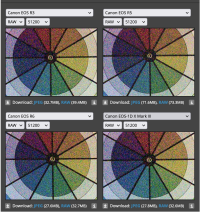That's what I thought, unfortunately it's an incorrect reading of the DxO low light score and really goes to show why the low light score is such a poor metric. The SNR is a component of the DxO low light score, but that score is determined by interpolating out the highest ISO setting that will satisfy a minimum value for three metrics: SNR, DR, and color depth. It's really the color depth one that tends to throw things off. Like I said earlier, your estimate of ~0.42 stops improvement in SNR between the R3 and R5 from the score is way off. DxO actually provides the SNR data and the reality is that the difference between the R5 and R3 is some where between 0.5-1dB, which corresponds to 1/12th to 1/6th of a stop. Nowhere close to 1/2 a stop.Go back to my post number 18 where DxOmark's numbers are in the image. The R3 has a low light iso of 4086 calculated by DxOmark from their S/N data, the R5 is 3042. The difference in stops (ev) is log(base2) of 4086/3042 = 0.4256.
Note the iso for the R6 is 3394, only 20% poorer than that of the R3, and for which I calculated 0.27 ev. I think my calculations must be consistent with DxOmark as they write: "A difference in low-light ISO of 25% equals 1/3 EV and is only slightly noticeable." https://www.dxomark.com/dxomark-camera-sensor-testing-protocol-and-scores/#sports
Upvote
0

